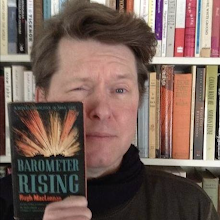
Harlequin? Really? Again?
Look, I'm more surprised than anyone at the number of times the publisher has appeared in this blog. Sure, it spews forth more books per annum than any other, but nothing in the last four decades has been even remotely interesting. And yet, Harlequin features in so many posts: those dealing with Brian Moore, Arthur Stringer, Gay Canadian Rogues, drug paperbacks, News Stand Library and, of course, its own 60th anniversary celebrations. I've had few kind words – and was, perhaps, a touch harsh about their SoHo gallery show – so, I felt pretty good about drawing attention to their series of vintage reissues a couple of months ago. "Whoever is overseeing this thing has done a very nice job", I wrote at the time.
Well, that person turns out to be Executive Editor Marsha Zinberg, who a few weeks later wrote about the collection on Harlequin's blog. Interesting stuff, it goes some way to explaining their strange choice of titles. "We wanted books whose cover art appealed to us," writes the editor, "and we had to be in physical possession of the book, but in some cases, once we started reading the text, we simply couldn’t see publishing the story, for a host of reasons….content, language, political correctness, etc. Several were eliminated, no matter how striking the cover!"
Then, Ms Zinberg casually drops a bomb:
Remember, our intention was to publish the stories in their original form. But once we immersed ourselves in the text, our eyes grew wide. Our jaws dropped. Social behavior — such as hitting a woman — that would be considered totally unacceptable now was quite common sixty years ago. Scenes of near rape would not sit well with a contemporary audience, we were quite convinced. We therefore decided to make small adjustments to the text, only in cases where we felt scenes or phrases would be offensive to a 2009 readership. Also, grammar and spelling standards have changed quite a bit in sixty years.

So, there you have it: not reissues, but bowdlerized editions designed for we sensitive, semi-literate souls of the 21st century. How strange, then, that Ms Zinberg should end her post:
Everyone in house has taken such interest and pride in this project, and we're delighted that the collection is now out in the marketplace. We hope they will also accomplish what the cover art exhibition attempted to do: "offer a unique insight into the profound changes that have occurred in women’s lives over the past six decades — from shifts in private desires to shifts in the politics of gender"!
Yes, profound changes that appear much less so thanks to the censor's blood red pen.
The comments section of Ms Zinberg's post indicates that initial reaction was quite positive. "Marsha, what a great story!" writes Harlequin author Jean Brashear. "What a fascinating journey!" chimes in unbiased stablemate Jeannie Watt. With one exception, all were quite friendly and congratulatory until late last week when it seems the post was discovered by pulp collectors. I can add nothing to their comments.
The truth out, I take back my complimentary words about the series and its editor. The kindest observation I'm able to offer at this point is that Harlequin has not seen fit to remove the post or comments from its blog.
Not yet, away.
Related posts:







